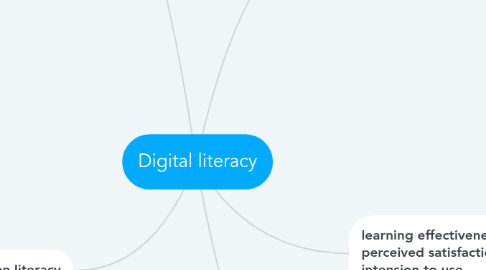
1. Digital literacy
1.1. 33. Development of digital literacy indicators for Thai undergraduate students using mixed method research (Techataweewan, W., & Prasertsin, U., 2018)
1.1.1. a sample consisting of 1,183 undergraduate students.
1.1.2. CFA
1.1.3. The first factor and its related operation skills consisted of cognition, invention, and presentation. The second factor was thinking skills consisting of analysis, evaluation, and creativity. The third factor was collaboration skills consisting of teamwork, networking, and sharing. The fourth factor was awareness skills consisting of ethics, law literacy, and safeguarding self.
1.2. 34. The current state and influential factors in the development of digital literacy in Thailand’s higher education (Tuamsuk, K., & Subramaniam, M., 2017)
1.2.1. administrators, lecturers and students of 116 Thai universities.
1.2.2. Descriptive statistics, T-test and F-test.
1.2.3. The study of factors related to digital literacy development showed that the respondents see that all of the factors affect students’ digital literacy development at a high level, including infrastructures, human resources, students’ awareness, external environments, development process, university’s policy and academic management.
1.3. 37. Defining the need: digital literacy skills for first-year university students (Öncül, G., 2020)
1.3.1. (1) a self-assessment survey, (2) an online test to collect indirect evidence and (3) a set of performance tasks. The third round, conducted with a different scope, enabled a final reliability check for the online test.
1.4. 39. Technology acceptance model and digital literacy of first year students in a private institution of higher learning in Malasia (Gie, T. A., & Fenn, C. J., 2019)
1.4.1. The Technology Acceptance Model (TAM)
1.4.1.1. ตัวแปรต้น perceived ease of use (PEOU) perceived usefulness (PU) ตัวแปรตาม Digital literacy
1.4.2. Descriptive analysis, T-Test, ANOVA and Spearman’s Correlation
2. Information literacy
2.1. 36. Assessment of information literacy skills and information-seeking behavior of medical students in the age of technology: a study of Pakistan (Haider, M. S., & Ya, C., 2021)
2.1.1. The undergraduate students of medical colleges Islamabad Pakistan.
2.1.2. Pearson correlation
3. Intention to use digital technology
3.1. 41. An assessment of the interplay between literacy and digital Technology in Higher Education (Nikou, S., & Aavakare, M., 2021)
3.1.1. Theory of acceptance and use of technology (UTAUT)
3.1.1.1. ตัวแปรต้น - Information literacy - Digital technology ตัวแปรคั่นกลาง - Performance expectancy - Effort expectancy ตัวแปรตาม - Intention to use digital technology
3.1.2. to examine the impact of information and digital literacy on 249 Finnish university staff and students’ intention to use digital technologies.
3.1.3. SEM
3.2. intention to use digital technology for learning
3.2.1. Theory of Acceptance and Use of Technology (UTAUT)
3.2.1.1. ตัวแปรต้น - digital literacy - information literacy ตัวแปรคั่นกลาง - performance expectancy - effort expectancy - habit - hedonic motivation. ตัวแปรตาม - intention to use digital technology for learning
3.2.1.1.1. 38. The Impact of Digital Literacy and Information Literacy on the Intention to use Digital Technologies for Learning (Aavakare, M., 2019)
3.2.1.1.2. 31. The impact of literacy on intention to use digital technology for learning: A comparative study of Korea and Finland (Nikou, S., & Aavakare, M., 2021)
3.2.1.2. SEM, multigroup analysis (MGA)
4. learning effectiveness perceived satisfaction intension to use
4.1. 40. The Effect of Digital Literacy on Learning in Higher Education (Kanthawongs, P., et al., 2016)
4.1.1. The Technology Acceptance Model (TAM)
4.1.1.1. ตัวแปรต้น Digital literacy ตัวแปรคั่นกลาง (Mediator) attitude ตัวแปรตาม learning effectiveness perceived satisfaction intension to use
4.1.2. The participants are 150 undergraduate students from Thailand
4.1.3. Path analysis
5. Adoption behavior
5.1. 32. Understanding factors influencing information communication technology adoption behavior: The moderators of information literacy and digital skills (Yu, T. K., Lin, M. L., & Liao, Y. K., 2017)
5.1.1. Media richness theory
5.1.1.1. ตัวแปรต้น - media richness - media technostress ตัวแปรคั่นกลาง (Mediator) - Media experience - Task characteristics - social interaction ตัวแปรกำกับ (Moderator) - information literacy - digital skill ตัวแปรตาม - adoption behavior
5.1.2. Using a survey of 875 participants survey a sample of Taiwan digital opportunity center communities
5.1.3. SEM
